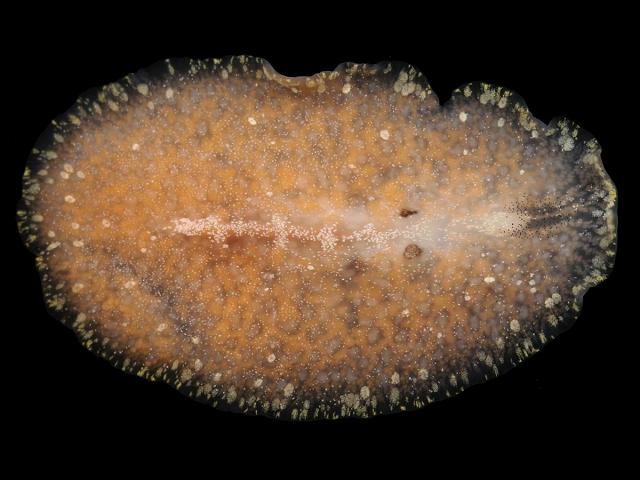
APHOTOMARINE
An educational resource dedicated mainly to the photography
and diversity of marine life that can be found in coastal waters
and intertidal areas of Great Britain and Ireland by David Fenwick.

Cycloporus papillosus (Sars, 1878) - A euryleptid polyclad turbellarian (Marine flatworms)
Scroll down and rollover titles to change screen image or click on title to view image.
Polyclad turbellarian
Cycloporus papillosus
- dorsal view 1
Cycloporus papillosus
- dorsal view 1
Polyclad turbellarian
Cycloporus papillosus
- dorsal view 2
Polyclad turbellarian
Cycloporus papillosus
- dorsal view 3
Polyclad turbellarian
Cycloporus papillosus
- dorsal view anterior
1
Polyclad turbellarian
Cycloporus papillosus
- dorsal view anterior 2
Polyclad turbellarian
Cycloporus papillosus
- papillae 1
Specimens above were found in a scrape sample of fouling taken from a pontoon at Newlyn Marina, Newlyn, Cornwall, 05.05.18 and 15.08.20.
Polyclad turbellarian
Cycloporus papillosus
on pink Botryllus schlosseri 1
Polyclad turbellarian
Cycloporus papillosus
on pink Botryllus schlosseri 2
Polyclad turbellarian
Cycloporus papillosus
on pink Botryllus schlosseri 3
Polyclad turbellarian
Cycloporus papillosus
on pink Botryllus schlosseri 4
Polyclad turbellarian
Cycloporus papillosus
- pink dorsal view 1
Specimens above found on star ascidian covered algae at Battery Rocks, Penzance, Cornwall. 18.12.16. N.B. The flatworm has taken on the colour of its food supply.
Polyclad turbellarian
Cycloporus papillosus
- dorsal view 4
Polyclad turbellarian
Cycloporus papillosus
- dorsal view 5
Polyclad turbellarian
Cycloporus papillosus
- dorsal view 6
Polyclad turbellarian
Cycloporus papillosus
- ventral view 1
Polyclad turbellarian
Cycloporus papillosus
- papillose surface 1
Polyclad turbellarian
Cycloporus papillosus
- dorsal view 7
Polyclad turbellarian
Cycloporus papillosus
- dorsal view 8
Polyclad turbellarian
Cycloporus papillosus
- anterior with eye pairs 1
Polyclad turbellarian
Cycloporus papillosus
- ventral view 2
Polyclad turbellarian
Cycloporus papillosus
- in-situ on colonial ascidian 1
Polyclad turbellarian
Cycloporus papillosus
- in-situ on colonial ascidian 2
Species above found under a rock on the lowershore near Smeaton's Pier, St. Ives, Cornwall. 26.09.14.
Polyclad turbellarian
Cycloporus papillosus
- on Star ascidian 1
Polyclad turbellarian
Cycloporus papillosus
- on Star ascidian 2
Polyclad turbellarian
Cycloporus papillosus
- papillae / tubercules 1
Polyclad turbellarian
Cycloporus papillosus
- on underside of rock 1
Polyclad turbellarian
Cycloporus papillosus
- feeding on Star ascidian 1
Polyclad turbellarian
Cycloporus papillosus
- feeding on Star ascidian 2
Polyclad turbellarian
Cycloporus papillosus
- feeding on Star ascidian 3
Polyclad turbellarian
Cycloporus papillosus
- feeding on Star ascidian 4
Polyclad turbellarian
Cycloporus papillosus
- feeding on Star ascidian 5
Polyclad turbellarian
Cycloporus papillosus
- feeding on Star ascidian 6
Polyclad turbellarian
Cycloporus papillosus
- feeding on Star ascidian 7
Polyclad turbellarian
Cycloporus papillosus
- feeding on Star ascidian 8
Polyclad turbellarian
Cycloporus papillosus
- underside 1
Polyclad turbellarian
Cycloporus papillosus
- two in-situ rock underside 1
Polyclad turbellarian
Cycloporus papillosus
- two in-situ rock underside 2
Images of species taken of animal found under a rock, on star ascidian, in a middleshore pool at Spit Point, Par, near St. Austell, Cornwall. 28.05.10. Species also found at numerous other locations, including Little London, Marazion, Cornwall. 24.08.13.
Polyclad turbellarian
Cycloporus papillosus
- two on Botrylloides leachii 1
Polyclad turbellarian
Cycloporus papillosus
- two on Botrylloides leachii 2
Specimens above found on Botrylloides leachii under a rock on the lowershore at Wembury, Devon, 28.03.06.
Please remember if turning rocks over to replace them carefully as they were found.

The main objective of this website is in furthering environmental awareness and education through the medium of photography. To increase awareness and access to the wildlife of the region and help
people find and identify it. Sometimes the difference between species is obvious but many species can only be determined by observing microscopic characteristics that are specific to any one species.